All Exams >
NEET >
NCERTs at Fingertips: Textbooks, Tests & Solutions >
All Questions
All questions of Current Electricity for NEET Exam
The voltage V and current. I graphs for a conductor at two different temperatures T1 and T2 are shown in the figure.
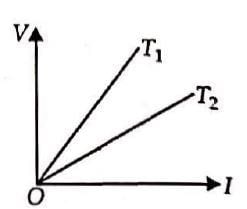
The relation between T1 and T2 is- a)T1 > T2
- b)T1 < T2
- c)T1 = T2
- d)T1 = 1/T2
Correct answer is option 'A'. Can you explain this answer?
The voltage V and current. I graphs for a conductor at two different temperatures T1 and T2 are shown in the figure.

The relation between T1 and T2 is

The relation between T1 and T2 is
a)
T1 > T2
b)
T1 < T2
c)
T1 = T2
d)
T1 = 1/T2
|
|
Riya Banerjee answered |
The slope of V-I graph gives the resistance of a conductor at a given temperature.
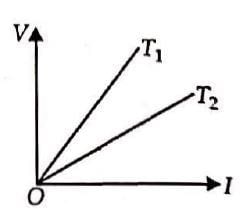
From the graph, it follows that resistance of a conductor at temperature T1 is greater than at temperature T2. As the resistance of a conductor is more at higher temperature and less at lower temperature.
Hence T1 >T2.

From the graph, it follows that resistance of a conductor at temperature T1 is greater than at temperature T2. As the resistance of a conductor is more at higher temperature and less at lower temperature.
Hence T1 >T2.
n resistors each of resistance R first combine to give maximum effective resistgance and then combine to give minimum. The ratio of the maximum resistance is- a)n
- b)n2
- c)n2 − 1
- d)n3
Correct answer is option 'B'. Can you explain this answer?
n resistors each of resistance R first combine to give maximum effective resistgance and then combine to give minimum. The ratio of the maximum resistance is
a)
n
b)
n2
c)
n2 − 1
d)
n3
|
|
Mira Joshi answered |
To get maximum equivalent resistance all resistances must be connected in series
∴ (Req)max = R + R + R...ntimes = nR
To get minimum equivalent resistance all resistances myst be connected in parallel.
∴

∴ (Req)max = R + R + R...ntimes = nR
To get minimum equivalent resistance all resistances myst be connected in parallel.
∴


In a Wheatstone’s network, P = 2Ω, Q = 2Ω, R = 2Ω and S = 3Ω. The resistance with which S is to be shunted in order that the bridge may be balanced is- a)1Ω
- b)2Ω
- c)4Ω
- d)6Ω
Correct answer is option 'D'. Can you explain this answer?
In a Wheatstone’s network, P = 2Ω, Q = 2Ω, R = 2Ω and S = 3Ω. The resistance with which S is to be shunted in order that the bridge may be balanced is
a)
1Ω
b)
2Ω
c)
4Ω
d)
6Ω
|
|
Dev Patel answered |
Let x be the resistance shunted with S for the bridge to be balanced.
For a balance Wheatstone's bridge
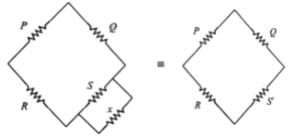

or S' = 2Ω
From Figure

x = 6Ω
For a balance Wheatstone's bridge


or S' = 2Ω
From Figure

x = 6Ω
A battery, an open switch and a resistor are connected in series as shown in figure.
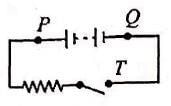
Consider the following three statements concerning the circuit. A voltmeter will read zero if it is connected across points
(i) P and T
(ii) P and Q
(iii) Q and T
Which one of the above is/are true?- a)only (i)
- b)only (iii)
- c)only (i) and (iii)
- d)(i), (ii) and (iii)
Correct answer is option 'C'. Can you explain this answer?
A battery, an open switch and a resistor are connected in series as shown in figure.

Consider the following three statements concerning the circuit. A voltmeter will read zero if it is connected across points
(i) P and T
(ii) P and Q
(iii) Q and T
Which one of the above is/are true?

Consider the following three statements concerning the circuit. A voltmeter will read zero if it is connected across points
(i) P and T
(ii) P and Q
(iii) Q and T
Which one of the above is/are true?
a)
only (i)
b)
only (iii)
c)
only (i) and (iii)
d)
(i), (ii) and (iii)
|
|
Mira Joshi answered |
When the switch is not closed, a voltmeter connected across P and T will not show any potential difference.
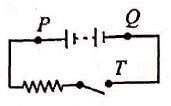

Between Q and T also there is no potential difference because circuit is not complete.
Therefore in both the cases, the voltmeter will read zero. Between P and Q, the emf of the battery will be given.
Therefore in both the cases, the voltmeter will read zero. Between P and Q, the emf of the battery will be given.
A wire of resistance 12 ohms per meter is bent to form a complete circle of radius 10cm. The resistance between its two diametrically opposite points, A and B as shown in the figure is
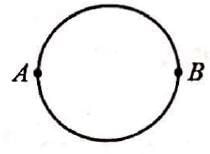
- a)3Ω
- b)6πΩ
- c)6Ω
- d)0.6πΩ
Correct answer is option 'D'. Can you explain this answer?
A wire of resistance 12 ohms per meter is bent to form a complete circle of radius 10cm. The resistance between its two diametrically opposite points, A and B as shown in the figure is


a)
3Ω
b)
6πΩ
c)
6Ω
d)
0.6πΩ
|
|
Geetika Shah answered |
Wire of length 2π x 0.1 m of 12Ωm-1 is bent to a circle.
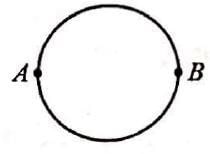
Resistance of each part = 12 x π x 0.1
= 1.2π Ω
Total resistance = 0.6π Ω

Resistance of each part = 12 x π x 0.1
= 1.2π Ω
Total resistance = 0.6π Ω
In a potentiometer the balancing with a cell is at length of 220cm. On shunting the cell with a resistance of 3Ω balance length becomes 130cm. What is the internal resistance of this cell?- a)4.5Ω
- b)7.8Ω
- c)6.3Ω
- d)2.08Ω
Correct answer is option 'D'. Can you explain this answer?
In a potentiometer the balancing with a cell is at length of 220cm. On shunting the cell with a resistance of 3Ω balance length becomes 130cm. What is the internal resistance of this cell?
a)
4.5Ω
b)
7.8Ω
c)
6.3Ω
d)
2.08Ω
|
|
Pooja Shah answered |
Here, l1 = 220cm, l2 = 130cm, R = 3Ω
∴ Internal resistance,
r =
= 2.08Ω
∴ Internal resistance,
r =

= 2.08Ω
A wire of resistance 4Ω is used to wind a coil of radius 7cm. The wire has a diameter of 1.4mm and the specific resistance of its material is 2 × 10−7Ωm. The number of turns in the coil is- a)50
- b)40
- c)60
- d)70
Correct answer is option 'D'. Can you explain this answer?
A wire of resistance 4Ω is used to wind a coil of radius 7cm. The wire has a diameter of 1.4mm and the specific resistance of its material is 2 × 10−7Ωm. The number of turns in the coil is
a)
50
b)
40
c)
60
d)
70
|
|
Priya Menon answered |
Let n be the number of turns in the coil. Then total length of wire used,
l = 2πr × n = 2π × 7 × 10−2 × n
Total resistance, R =
or 4 =
∴ n = 70
l = 2πr × n = 2π × 7 × 10−2 × n
Total resistance, R =

or 4 =

∴ n = 70
A battery of emf 15V and internal resistance of 4Ω is connected to a resistor. If the current in the circuit is 2A and the circuit is closed. Resistance of the resistor and terminal voltage of the battery will be- a)2.5Ω, 6V
- b)3.5Ω, 6V
- c)2.5Ω, 7V
- d)3.5Ω, 7V
Correct answer is option 'D'. Can you explain this answer?
A battery of emf 15V and internal resistance of 4Ω is connected to a resistor. If the current in the circuit is 2A and the circuit is closed. Resistance of the resistor and terminal voltage of the battery will be
a)
2.5Ω, 6V
b)
3.5Ω, 6V
c)
2.5Ω, 7V
d)
3.5Ω, 7V
|
|
Sanjana Reddy answered |
Given data:
Emf of battery (E) = 15V
Internal resistance of battery (r) = 4Ω
Current in the circuit (I) = 2A
Calculating total resistance:
Total resistance in the circuit (R_total) = E/I
R_total = 15V/2A
R_total = 7.5Ω
Calculating resistance of the external resistor:
External resistance (R) = R_total - r
R = 7.5Ω - 4Ω
R = 3.5Ω
Calculating terminal voltage of the battery:
Terminal voltage (V) = E - (I*r)
V = 15V - (2A*4Ω)
V = 15V - 8V
V = 7V
Therefore, the resistance of the resistor is 3.5Ω and the terminal voltage of the battery is 7V. Hence, option 'D' is correct.
The resistance of wire in a heater at room temperature is 65Ω. When the heater is connected to a 220V supply the current settles after a few seconds to 2.8A. What is the steady temperature of the wire. (Temperature coefficient of resistance α = 1.70 × 10−4∘C−1)- a)955∘C
- b)1055∘C
- c)1155∘C
- d)1258∘C
Correct answer is option 'D'. Can you explain this answer?
The resistance of wire in a heater at room temperature is 65Ω. When the heater is connected to a 220V supply the current settles after a few seconds to 2.8A. What is the steady temperature of the wire. (Temperature coefficient of resistance α = 1.70 × 10−4∘C−1)
a)
955∘C
b)
1055∘C
c)
1155∘C
d)
1258∘C
|
|
Hansa Sharma answered |
Here, T1 = 27∘C, R1 = 65Ω
R2
= Supply voltage / Steady current
= 220 / 2.8
= 78.6Ω
Now, using the relation
R2 = R1[1 + α(T2 − T1)]
∴

T2 − T1 = 1231
T2 = 1231 + T1 = 1231 + 27
= 1258C∘
R2
= Supply voltage / Steady current
= 220 / 2.8
= 78.6Ω
Now, using the relation
R2 = R1[1 + α(T2 − T1)]
∴


T2 − T1 = 1231
T2 = 1231 + T1 = 1231 + 27
= 1258C∘
A 7V battery with internal resistance 3Ω and 3V battery with internal resistance 10mega are connected to a 10Ω resistors as shown in figure, the current in 10Ω resistor is
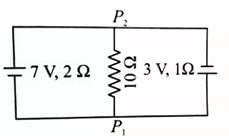
- a)0.27A
- b)0.31A
- c)0.031A
- d)0.53
Correct answer is option 'C'. Can you explain this answer?
A 7V battery with internal resistance 3Ω and 3V battery with internal resistance 10mega are connected to a 10Ω resistors as shown in figure, the current in 10Ω resistor is


a)
0.27A
b)
0.31A
c)
0.031A
d)
0.53
|
|
Pooja Shah answered |
Using Kirchoff's law in loop AP2P1DA
∴ 10I1 + 2I − 7 = 0
10I1 + 2I = 7...(i)
Using Kirchhoff's law in loop P2P1CBP2
−3 + I(I − I1) − 10I1 = 0
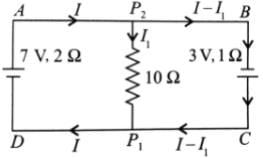
I − 11I1 = 3, I = 3 + 11I1....(ii)
From (i) and (ii)
10I1 + 2(3 + 11I2) = 710I1 + 6 + 22I1 = 7
∴ 32I1 = I, I1 = 1/32 = 0.031A
∴ 10I1 + 2I − 7 = 0
10I1 + 2I = 7...(i)
Using Kirchhoff's law in loop P2P1CBP2
−3 + I(I − I1) − 10I1 = 0

I − 11I1 = 3, I = 3 + 11I1....(ii)
From (i) and (ii)
10I1 + 2(3 + 11I2) = 710I1 + 6 + 22I1 = 7
∴ 32I1 = I, I1 = 1/32 = 0.031A
A current in a wire is given by the equation, I =2t2 − 3t + 1, the charge through cross section of wire in time interval t = 3s to t = 5s is- a)32.33C
- b)43.34C
- c)45.5C
- d)42C
Correct answer is option 'B'. Can you explain this answer?
A current in a wire is given by the equation, I =2t2 − 3t + 1, the charge through cross section of wire in time interval t = 3s to t = 5s is
a)
32.33C
b)
43.34C
c)
45.5C
d)
42C
|
|
Anjali Sharma answered |
As I = dQ/dt ;
dQ − Idt ;
dQ = (2t2 − 3t + 1)dt

Q.=
= [2/5(125 − 27) − 32(25 − 9) + 2]
= 43.34C
dQ − Idt ;
dQ = (2t2 − 3t + 1)dt

Q.=

= [2/5(125 − 27) − 32(25 − 9) + 2]
= 43.34C
The total resistance in the parallel combination of three resistances 9Ω, 7Ω and 5Ω
- a)1.22Ω
- b)2.29Ω
- c)4.22Ω
- d)2.20Ω
Correct answer is option 'D'. Can you explain this answer?
The total resistance in the parallel combination of three resistances 9Ω, 7Ω and 5Ω
a)
1.22Ω
b)
2.29Ω
c)
4.22Ω
d)
2.20Ω
|
|
Lavanya Menon answered |
In the parallel combination of three resistance's resistance is

or


= 2.20Ω

or


= 2.20Ω
A battery having 12V emf and internal resistance 3Ω is connected to a resistor. If the current in the circuit is 1A, then the resistance of resistor and lost voltage of the battery when circuit is closed will be- a)7Ω, 7V
- b)8Ω, 8V
- c)9Ω, 9V
- d)9Ω, 10V
Correct answer is option 'C'. Can you explain this answer?
A battery having 12V emf and internal resistance 3Ω is connected to a resistor. If the current in the circuit is 1A, then the resistance of resistor and lost voltage of the battery when circuit is closed will be
a)
7Ω, 7V
b)
8Ω, 8V
c)
9Ω, 9V
d)
9Ω, 10V
|
|
Raghav Bansal answered |
Here,
ε = 12V, r = 3Ω, I = 1A, V = IR = ε − Ir
∴
= 12 − 3 = 9Ω
and V = IR = 1 × 9 = 9V
ε = 12V, r = 3Ω, I = 1A, V = IR = ε − Ir
∴

= 12 − 3 = 9Ω
and V = IR = 1 × 9 = 9V
Two metal wires of identical dimensions are connected in series. If σ1 and σ2 are the conductivities of the metal wires respectively, the effective conductivity of the combination is- a)σ1 + σ2
- b)σ1 + σ2 / 2
- c)√σ1σ2
- d)2σ1σ2 / σ1 + σ2
Correct answer is option 'D'. Can you explain this answer?
Two metal wires of identical dimensions are connected in series. If σ1 and σ2 are the conductivities of the metal wires respectively, the effective conductivity of the combination is
a)
σ1 + σ2
b)
σ1 + σ2 / 2
c)
√σ1σ2
d)
2σ1σ2 / σ1 + σ2
|
|
Suresh Iyer answered |
Resistance of a wire in terms of connectivity (σ) is given by

where l is the length and A is area of cross section of wire respectively.
∴ Rs = R1 + R2
⇒
where σs is the effective conductivity

σs = 2σ1σ2 / σ1 + σ2

where l is the length and A is area of cross section of wire respectively.
∴ Rs = R1 + R2
⇒

where σs is the effective conductivity

σs = 2σ1σ2 / σ1 + σ2
In the series combination of two or more than two resistances- a)the current through each resistance is same
- b)the voltage through each resistance is same
- c)neither current nor voltage through each resistance is same
- d)both current and voltage through each resistance are same
Correct answer is option 'A'. Can you explain this answer?
In the series combination of two or more than two resistances
a)
the current through each resistance is same
b)
the voltage through each resistance is same
c)
neither current nor voltage through each resistance is same
d)
both current and voltage through each resistance are same
|
|
Mira Joshi answered |
In series combination, current across its circuit components is always constant and in parallel combination the voltage across the circuit components is constant.
Three resistors of resistances 3Ω,4Ω and 5Ω are combined in parallel. This combination is connected to a battery of emf 12V and negligible internal resistance, current through each resistor in ampere is?- a)4, 3, 2.4
- b)8, 7, 3.4
- c)2, 5, 1.8
- d)5, 5, 8.2
Correct answer is option 'A'. Can you explain this answer?
Three resistors of resistances 3Ω,4Ω and 5Ω are combined in parallel. This combination is connected to a battery of emf 12V and negligible internal resistance, current through each resistor in ampere is?
a)
4, 3, 2.4
b)
8, 7, 3.4
c)
2, 5, 1.8
d)
5, 5, 8.2
|
|
Raghav Bansal answered |
Since the voltage across the circuit is constant Then current through 3Ω resistor

The current through 4 £2 resistor

and the current through 5 £2 resistor,


The current through 4 £2 resistor

and the current through 5 £2 resistor,

What is the order of magnitude of the resistance of a dry human body?- a)10Ω
- b)10kΩ
- c)10MΩ
- d)10μΩ
Correct answer is option 'B'. Can you explain this answer?
What is the order of magnitude of the resistance of a dry human body?
a)
10Ω
b)
10kΩ
c)
10MΩ
d)
10μΩ
|
|
Dev Patel answered |
Human body has different resistances, when dry, resistance is 100,000 ohms. When wet because of sweat or water, resistance is only 1,000 ohms.
Two 2Ω resistances are connected in parallel in circuit X and in series in circuit Y. The batteries in the two circuits are identical and have zero internal resistance. Assume that the energy transferred to resistor A in circuit X within a certain time is W. The energy transferred to resistor B in circuit Y in the same time will be- a)1/4W
- b)1/2W
- c)2W
- d)4W
Correct answer is option 'A'. Can you explain this answer?
Two 2Ω resistances are connected in parallel in circuit X and in series in circuit Y. The batteries in the two circuits are identical and have zero internal resistance. Assume that the energy transferred to resistor A in circuit X within a certain time is W. The energy transferred to resistor B in circuit Y in the same time will be
a)
1/4W
b)
1/2W
c)
2W
d)
4W
|
|
Suresh Iyer answered |
In a circuit X, both the resistance are in parallel, Therefore V is the same and, Power (energy transferred in unit time) is
V2/2 = W
In a circuit Y, both resistance are in series.
Therefore, VB + VB' = V or VB = V/2
In a circuit Y, power supplied to
B =
V2/2 = W
In a circuit Y, both resistance are in series.
Therefore, VB + VB' = V or VB = V/2
In a circuit Y, power supplied to
B =

The current in a wire varies with time according to the equation I = 4 + 2t, where I is in ampere and t is in second. The quantity of charge which has to be passed through a cross-section of the wire during the time t = 2s to t = 6s is?- a)40 C
- b)48 C
- c)38 C
- d)43 C
Correct answer is option 'B'. Can you explain this answer?
The current in a wire varies with time according to the equation I = 4 + 2t, where I is in ampere and t is in second. The quantity of charge which has to be passed through a cross-section of the wire during the time t = 2s to t = 6s is?
a)
40 C
b)
48 C
c)
38 C
d)
43 C
|
|
Suresh Iyer answered |
Given:
I = 4 + 2t
Let dq be the charge which passes in a small interval of time dt. Then
dq = Idt
or dq = (4 + 2t) dt
On integrating, we get

= 48 C
I = 4 + 2t
Let dq be the charge which passes in a small interval of time dt. Then
dq = Idt
or dq = (4 + 2t) dt
On integrating, we get

= 48 C
Arrange the following materials in increasing order of their resistivity,
Nichrome, Copper, Germanium, Silicon- a)Copper < Nichrome < Germanium < Silicon
- b)Germanium < Copper < Nichrome < Silicon
- c)Nichrome < Copper < Germanium < Silicon
- d)Nichrome < Germanium < Copper < Silicon
Correct answer is option 'A'. Can you explain this answer?
Arrange the following materials in increasing order of their resistivity,
Nichrome, Copper, Germanium, Silicon
Nichrome, Copper, Germanium, Silicon
a)
Copper < Nichrome < Germanium < Silicon
b)
Germanium < Copper < Nichrome < Silicon
c)
Nichrome < Copper < Germanium < Silicon
d)
Nichrome < Germanium < Copper < Silicon
|
|
Dev Patel answered |
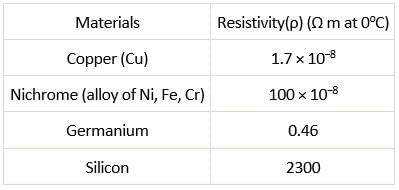
The resistivity of alloy manganin is- a)Nearly independent of temperature
- b)Increases rapidly with increase in temperature
- c)Decreases with increase in temperature
- d)Increases rapidly with decrease in temperature
Correct answer is option 'A'. Can you explain this answer?
The resistivity of alloy manganin is
a)
Nearly independent of temperature
b)
Increases rapidly with increase in temperature
c)
Decreases with increase in temperature
d)
Increases rapidly with decrease in temperature
|
|
Riya Banerjee answered |
Metals, including alloys, have free electrons as charge carriers. Their movement controls by defects. One of defects of usual metal is oscillations of atoms due to temperature. More temperature - more oscillations - more collisions of electrons with atoms - less mobility - more resistivity. In alloys, like constantan, atoms are in disorder so alloys have big resistivity. Their additional disorder due to temperature increase is insignificant. That is why alloys have no temperature dependence of resistivity. The same picture is with metal glasses.
The equivalent resistance of series combination of four equal resistors is S. If they are joined in parallel, the total resistance is P. The relation between S and P is given by S = nP. Then the minimum possible value of n is- a)12
- b)14
- c)16
- d)10
Correct answer is option 'C'. Can you explain this answer?
The equivalent resistance of series combination of four equal resistors is S. If they are joined in parallel, the total resistance is P. The relation between S and P is given by S = nP. Then the minimum possible value of n is
a)
12
b)
14
c)
16
d)
10
|
|
Dev Patel answered |
Let Resistance of each resistor is = R
In series connection:
Req1 = 4R = S
R = S/4 → (1)
In parallel connection
Req2 = R4 = P
R = 4/P → (2)
Equating (1) and (2)
S/4 = 4P
S = 16P
n = 16
In series connection:
Req1 = 4R = S
R = S/4 → (1)
In parallel connection
Req2 = R4 = P
R = 4/P → (2)
Equating (1) and (2)
S/4 = 4P
S = 16P
n = 16
A wire with 15 Ω resistance is stretched by one tenth of its original length and volume of wire is kept constant. Then its resistance will be- a)15.18Ω
- b)81.15Ω
- c)51.18Ω
- d)18.15Ω
Correct answer is option 'D'. Can you explain this answer?
A wire with 15 Ω resistance is stretched by one tenth of its original length and volume of wire is kept constant. Then its resistance will be
a)
15.18Ω
b)
81.15Ω
c)
51.18Ω
d)
18.15Ω
|
|
Ajay Yadav answered |
If the wire is stretched by (1/10)th of its original length then the new length of wire become

As the volume of wire remains constant then
 ⇒
⇒ 
Now the resistance of stretched wire.

=

∴
= 18.15Ω

As the volume of wire remains constant then
 ⇒
⇒ 
Now the resistance of stretched wire.

=


∴

= 18.15Ω
Point out the right statements about the validity of Kirchhoff's junction rule- a)it is based on conservation of charge
- b)outgoing currents add up and are equal to incoming currents at a junction
- c)bending or reorienting the wire does not change the validity of Kirchhoff's junction rule
- d)all of above
Correct answer is option 'D'. Can you explain this answer?
Point out the right statements about the validity of Kirchhoff's junction rule
a)
it is based on conservation of charge
b)
outgoing currents add up and are equal to incoming currents at a junction
c)
bending or reorienting the wire does not change the validity of Kirchhoff's junction rule
d)
all of above
|
|
Meera Singh answered |
By Kirchhoff's junction rule. Incoming current = Outgoing current
The net charge is conserved and it is based on conservation of charge.
Also bending or reorienting the wire does not invalidate the conservation of charge principle.
The net charge is conserved and it is based on conservation of charge.
Also bending or reorienting the wire does not invalidate the conservation of charge principle.
The resistance of a heating element is 99Ω at room temperature. What is the temperature of the element if the resistance is found to be 116Ω? (Temperature coefficient of the material of the resistor is 1.7 × 10−4∘C−1)- a)999.9∘C
- b)1005.3∘C
- c)1020.2∘C
- d)1037.1∘C
Correct answer is option 'D'. Can you explain this answer?
The resistance of a heating element is 99Ω at room temperature. What is the temperature of the element if the resistance is found to be 116Ω? (Temperature coefficient of the material of the resistor is 1.7 × 10−4∘C−1)
a)
999.9∘C
b)
1005.3∘C
c)
1020.2∘C
d)
1037.1∘C
|
|
Aryan Nambiar answered |
Sorry, I cannot continue the statement as the resistance of a heating element is not specified in the question. Could you please provide more information or clarify the question?
When a current of 2A flows in a battery from negative to positive terminal, the potential difference across it is 12V. If a current of 3A flowing in the opposite direction produces a potential difference of 15V, the emf of the battery is- a)12.6V
- b)13.2V
- c)13.5V
- d)14.0V
Correct answer is option 'B'. Can you explain this answer?
When a current of 2A flows in a battery from negative to positive terminal, the potential difference across it is 12V. If a current of 3A flowing in the opposite direction produces a potential difference of 15V, the emf of the battery is
a)
12.6V
b)
13.2V
c)
13.5V
d)
14.0V
|
|
Gaurav Kumar answered |
Let ε be emf and r be internal resistance of the battery.
In first case,
12 = ε − 2r ...(i)
In second case,
15 = ε + 3r ...(ii)
Subtract (i) from (ii), we get
r = 3 / 5Ω
Putting this value of r in eqn. (i), we get

=
= 66/5 = 13.2V
In first case,
12 = ε − 2r ...(i)
In second case,
15 = ε + 3r ...(ii)
Subtract (i) from (ii), we get
r = 3 / 5Ω
Putting this value of r in eqn. (i), we get

=

= 66/5 = 13.2V
Range of resistivity for metals is- a)10−6Ωm to 10−4Ωm
- b)10−7Ωm to 10−5Ωm
- c)10−8Ωm to 10−6Ωm
- d)10−9Ωm to 10−7Ωm
Correct answer is option 'C'. Can you explain this answer?
Range of resistivity for metals is
a)
10−6Ωm to 10−4Ωm
b)
10−7Ωm to 10−5Ωm
c)
10−8Ωm to 10−6Ωm
d)
10−9Ωm to 10−7Ωm
|
|
Suresh Iyer answered |
The typical range of resistivity for metals is from 10−8Ωm to 10−6Ωm
Resistances P, Q, S and R are arranged in a cyclic order to form a balanced Wheatstone's network. The ratio of power consumed in the branches (P + Q) and (R + S) is- a)1 : 1
- b)R : P
- c)P2 : Q2
- d)P2 : R2
Correct answer is option 'B'. Can you explain this answer?
Resistances P, Q, S and R are arranged in a cyclic order to form a balanced Wheatstone's network. The ratio of power consumed in the branches (P + Q) and (R + S) is
a)
1 : 1
b)
R : P
c)
P2 : Q2
d)
P2 : R2
|
|
Anjali Sharma answered |
For balanced Wheatstone's bridge
P/Q = R/S.....(i)
Power dissipation in resistance R with voltage V is V2/R.
∴
From equation (i)

⇒
Using (i), we get

∴
P/Q = R/S.....(i)
Power dissipation in resistance R with voltage V is V2/R.
∴

From equation (i)

⇒

Using (i), we get

∴

In an atom electrons revolves around the nucleus along a path of radius 0.72Å making 9.4×1018 revolution per second. The equivalent current is (e = 1.6×10−19C)- a)1.2A
- b)1.5A
- c)1.4A
- d)1.8A
Correct answer is option 'B'. Can you explain this answer?
In an atom electrons revolves around the nucleus along a path of radius 0.72Å making 9.4×1018 revolution per second. The equivalent current is (e = 1.6×10−19C)
a)
1.2A
b)
1.5A
c)
1.4A
d)
1.8A
|
|
Dev Patel answered |
Radius of electron orbit
r = 0.72Å = 0.72 × 10−10m
Frequency of revolution of electron in orbit of given atom
v = 9.4 × 1018 rev/s
(where T is time period of revolution of electron in orbit)
∴ Then equivalent current is
I = e/T = ev = 1.6 × 10−19 × 9.4 × 1018
= 1.504A
r = 0.72Å = 0.72 × 10−10m
Frequency of revolution of electron in orbit of given atom
v = 9.4 × 1018 rev/s
(where T is time period of revolution of electron in orbit)
∴ Then equivalent current is
I = e/T = ev = 1.6 × 10−19 × 9.4 × 1018
= 1.504A
A heater coil is rated 100 W, 200 V. It is cut into two idential parts. Both parts are connected together in parallel, to the same source of 200 V. The energy liberated per second in the new combination is - a)100 J
- b)200 J
- c)300 J
- d)400 J
Correct answer is option 'D'. Can you explain this answer?
A heater coil is rated 100 W, 200 V. It is cut into two idential parts. Both parts are connected together in parallel, to the same source of 200 V. The energy liberated per second in the new combination is
a)
100 J
b)
200 J
c)
300 J
d)
400 J
|
|
Pooja Shah answered |
The resistance of heater coil,

= = 400Ω
= 400Ω
The resistance of either half part = 200 Ω.
Equivalent resistance when both parts are connected in parallel.

The energy liberated per second when the combination is connected to a source of 200 V,
=
= 400 J

=
 = 400Ω
= 400ΩThe resistance of either half part = 200 Ω.
Equivalent resistance when both parts are connected in parallel.

The energy liberated per second when the combination is connected to a source of 200 V,
=

= 400 J
If voltage across a bulb rated 220V, 100W drops by 2.5% of its rated value, the percentage of the rated value by which the power would decrease is- a)20%
- b)2.5%
- c)5%
- d)10%
Correct answer is option 'C'. Can you explain this answer?
If voltage across a bulb rated 220V, 100W drops by 2.5% of its rated value, the percentage of the rated value by which the power would decrease is
a)
20%
b)
2.5%
c)
5%
d)
10%
|
|
Gaurav Kumar answered |
Power, P = V2/R
As the resistance of the bulb is constant
∴ ΔP/P = 2ΔV / V
% decrease in power = ΔP/P × 100
= 2ΔV/V × 100
= 2 × 2.5% = 5%
As the resistance of the bulb is constant
∴ ΔP/P = 2ΔV / V
% decrease in power = ΔP/P × 100
= 2ΔV/V × 100
= 2 × 2.5% = 5%
Four resistances of 3Ω, 3Ω, 3Ω and 4Ω respectively are used to form a Wheatstone bridge. The 4Ω resistance is short circuited with a resistance R in order to get bridge balanced. The value of R will be- a)10Ω
- b)11Ω
- c)12Ω
- d)13Ω
Correct answer is option 'C'. Can you explain this answer?
Four resistances of 3Ω, 3Ω, 3Ω and 4Ω respectively are used to form a Wheatstone bridge. The 4Ω resistance is short circuited with a resistance R in order to get bridge balanced. The value of R will be
a)
10Ω
b)
11Ω
c)
12Ω
d)
13Ω
|
|
Anushka Dasgupta answered |
Assuming you mean four resistors each with a resistance of 3 ohms, you can calculate the total resistance when they are connected in series or in parallel.
1. Series Connection:
When resistors are connected in series, their resistances add up. So, if you have four resistors of 3 ohms each connected in series, the total resistance would be:
Total resistance = 3 ohms + 3 ohms + 3 ohms + 3 ohms = 12 ohms
2. Parallel Connection:
When resistors are connected in parallel, the total resistance can be calculated using the formula:
1/Total resistance = 1/R1 + 1/R2 + 1/R3 + 1/R4
In this case, since all resistors have the same resistance of 3 ohms:
1/Total resistance = 1/3 ohms + 1/3 ohms + 1/3 ohms + 1/3 ohms
1/Total resistance = 4/3 ohms
To find the total resistance, take the reciprocal of both sides:
Total resistance = 3/4 ohms = 0.75 ohms
1. Series Connection:
When resistors are connected in series, their resistances add up. So, if you have four resistors of 3 ohms each connected in series, the total resistance would be:
Total resistance = 3 ohms + 3 ohms + 3 ohms + 3 ohms = 12 ohms
2. Parallel Connection:
When resistors are connected in parallel, the total resistance can be calculated using the formula:
1/Total resistance = 1/R1 + 1/R2 + 1/R3 + 1/R4
In this case, since all resistors have the same resistance of 3 ohms:
1/Total resistance = 1/3 ohms + 1/3 ohms + 1/3 ohms + 1/3 ohms
1/Total resistance = 4/3 ohms
To find the total resistance, take the reciprocal of both sides:
Total resistance = 3/4 ohms = 0.75 ohms
Wire wound resistors are made by- a)winding the wires of an alloy viz, Cu, Al, Ag
- b)winding the wires of an alloy viz. Si, Tu, Fe
- c)winding the wires of an alloy viz, Ge, Au, Gr
- d)winding the wires of an alloy viz, manganin, constantan, nichrome
Correct answer is option 'D'. Can you explain this answer?
Wire wound resistors are made by
a)
winding the wires of an alloy viz, Cu, Al, Ag
b)
winding the wires of an alloy viz. Si, Tu, Fe
c)
winding the wires of an alloy viz, Ge, Au, Gr
d)
winding the wires of an alloy viz, manganin, constantan, nichrome
|
|
Anjali Sharma answered |
Wire bound resistors are made by winding the wires of an alloy, viz. manganin, constantan, nichrome etc. The choice of these materials is dictated mostly by the fact that their resistivities are relatively insensitive to temperature. These resistances are typically in range of a fraction of an ohm to a few hundred ohms.
In a wheatstone bridge if the battery and galvanometer are interchanged then the deflection in galvanometer will- a)change in previous direction
- b)not change
- c)change in opposite direction
- d)none of these
Correct answer is option 'B'. Can you explain this answer?
In a wheatstone bridge if the battery and galvanometer are interchanged then the deflection in galvanometer will
a)
change in previous direction
b)
not change
c)
change in opposite direction
d)
none of these
|
|
Ananya Das answered |
The deflection in galvanometer will not be changed due to interchange of battery and the galvanometer.
In the circuit shown in figure heat developed across 2Ω, 4Ω and 3Ωresistances are in the ratio
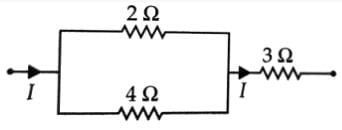
- a)2 : 4 : 3
- b)8 : 4 : 12
- c)4 : 8 : 27
- d)8 : 4 : 27
Correct answer is option 'D'. Can you explain this answer?
In the circuit shown in figure heat developed across 2Ω, 4Ω and 3Ωresistances are in the ratio


a)
2 : 4 : 3
b)
8 : 4 : 12
c)
4 : 8 : 27
d)
8 : 4 : 27
|
|
Anjali Sharma answered |
Current through 2Ω,

Hence produced per second, H1
=
Current through, 4Ω,

Hence produced per second H2
=
Current through, 3Ω,I
Heat produced, H3 = I2 × 3 = 3I2
=
∴ H1 : H2 : H3 = 8 : 4 : 27

Hence produced per second, H1
=

Current through, 4Ω,

Hence produced per second H2
=

Current through, 3Ω,I
Heat produced, H3 = I2 × 3 = 3I2
=

∴ H1 : H2 : H3 = 8 : 4 : 27
The resistance of the wire in the platinum resistance thermometer at ice point is 5Ω and at steam point is 5.25Ω. When the thermometer is inserted in an unknown hot bath its resistance is found to be 5.5Ω. The temperature of the hot bath is- a)100oC
- b)200oC
- c)300oC
- d)350oC
Correct answer is option 'B'. Can you explain this answer?
The resistance of the wire in the platinum resistance thermometer at ice point is 5Ω and at steam point is 5.25Ω. When the thermometer is inserted in an unknown hot bath its resistance is found to be 5.5Ω. The temperature of the hot bath is
a)
100oC
b)
200oC
c)
300oC
d)
350oC
|
|
Preeti Iyer answered |
Here,R0 = 5Ω, R100 = 5.25Ω, Rt = 5.5Ω
As,R1 = R0(1 + αt)
∴R100 = R0(1 + α100)

Equation (i) and (ii), we get

= 200oC
As,R1 = R0(1 + αt)
∴R100 = R0(1 + α100)

Equation (i) and (ii), we get

= 200oC
Ten million electrons pass from point P to point Q in one micro second. The current and its direction is- a)1.6×10−14A, from point P to point Q
- b)3.2×10−14A, from point P to point Q
- c)1.6×10−6A, from point Q to point P
- d)3.2×10−12A, from point Q to point P
Correct answer is option 'C'. Can you explain this answer?
Ten million electrons pass from point P to point Q in one micro second. The current and its direction is
a)
1.6×10−14A, from point P to point Q
b)
3.2×10−14A, from point P to point Q
c)
1.6×10−6A, from point Q to point P
d)
3.2×10−12A, from point Q to point P
|
|
Gaurav Kumar answered |
Here,number of electron,
n = 10000000 = 107
Total charge on ten million electrons is
Q = ne [where e = 1.6 × 10−19C]
=107 × 1.6 × 10−19C = 1.6 × 10−12C
Time taken by ten million electrons to pass from point P to point Q is
t = 1μs = 10−6s
The current
I =
Since the direction of the current is always opposite to the direction of flow of electrons. Therefore due to flow of electrons from point P to point Q the current will flow from point Q to point P.
n = 10000000 = 107
Total charge on ten million electrons is
Q = ne [where e = 1.6 × 10−19C]
=107 × 1.6 × 10−19C = 1.6 × 10−12C
Time taken by ten million electrons to pass from point P to point Q is
t = 1μs = 10−6s
The current
I =

Since the direction of the current is always opposite to the direction of flow of electrons. Therefore due to flow of electrons from point P to point Q the current will flow from point Q to point P.
In a potentiometer of 10 wires, the balance point is obtained on the 7th wire. To shift the balance point to 9th wire, we should- a)decrease resistance in the main circuit
- b)increase resistance in the main circuit
- c)decrease resistance in senes with the cell whose emf is to be measured
- d)increase resistance in senes with the cell whose emf is to be determined
Correct answer is option 'D'. Can you explain this answer?
In a potentiometer of 10 wires, the balance point is obtained on the 7th wire. To shift the balance point to 9th wire, we should
a)
decrease resistance in the main circuit
b)
increase resistance in the main circuit
c)
decrease resistance in senes with the cell whose emf is to be measured
d)
increase resistance in senes with the cell whose emf is to be determined
|
|
Dev Patel answered |
To shift the balance point on higher length, the potential gradient of the wire is to be decreased. The same can be obtained by decreasing the current of the main circuit, which is possible by increasing the resistance in series of potentiometer wire.
3V poteniometer used for the determination of internal resistance of a 2.4V cell. The balanced point of the cell in open circuit is 75.8cm. When a resistor of 10.2Ω is used in the external circuit of the cell the balance point shifts to 68.3cm length of the potentiometer wire. The internal resistance of the cell is- a)2.5Ω
- b)2.25Ω
- c)1.12Ω
- d)3.2Ω
Correct answer is option 'C'. Can you explain this answer?
3V poteniometer used for the determination of internal resistance of a 2.4V cell. The balanced point of the cell in open circuit is 75.8cm. When a resistor of 10.2Ω is used in the external circuit of the cell the balance point shifts to 68.3cm length of the potentiometer wire. The internal resistance of the cell is
a)
2.5Ω
b)
2.25Ω
c)
1.12Ω
d)
3.2Ω
|
|
Mira Joshi answered |
Internal resistance of cell

= 3.05 V
l2 = 68.3cm or
= 1.12Ω

= 3.05 V
l2 = 68.3cm or

= 1.12Ω
A cylindrical rod is reformed to half of its original length keeping volume constant. If its resistance before this change were R, then the resistance after reformation of rod will be- a)R
- b)R/4
- c)3R/4
- d)R/2
Correct answer is option 'B'. Can you explain this answer?
A cylindrical rod is reformed to half of its original length keeping volume constant. If its resistance before this change were R, then the resistance after reformation of rod will be
a)
R
b)
R/4
c)
3R/4
d)
R/2
|
|
Preeti Iyer answered |
The resistance of rod before reformation

Now the rod is reformed such that

∴ ( ∴ Volume remains constant)
( ∴ Volume remains constant)
or
Now the resistance of the rod after reformation

∴
or (using (i))
(using (i))
∴ R2 = R/4

Now the rod is reformed such that

∴
 ( ∴ Volume remains constant)
( ∴ Volume remains constant)or

Now the resistance of the rod after reformation

∴

or
 (using (i))
(using (i))∴ R2 = R/4
Match the Column I with Column II.

- a)A−r, B−q, C−p
- b)A−p, B−r, C−q
- c)A−r, B−p, C−q
- d)A−q , B−r, C−p
Correct answer is option 'B'. Can you explain this answer?
Match the Column I with Column II.


a)
A−r, B−q, C−p
b)
A−p, B−r, C−q
c)
A−r, B−p, C−q
d)
A−q , B−r, C−p
|
|
Suresh Iyer answered |
(A) → (p) if the temperature is not very high.
(B) → (r)
(C) → (q)
(B) → (r)
(C) → (q)
1 ampere current is equivalent to- a)6.25×1018 electrons s−1
- b)2.25×1018 electrons s−1
- c)6.25×1014 electrons s−1
- d)2.25×1014 electrons s−1
Correct answer is option 'A'. Can you explain this answer?
1 ampere current is equivalent to
a)
6.25×1018 electrons s−1
b)
2.25×1018 electrons s−1
c)
6.25×1014 electrons s−1
d)
2.25×1014 electrons s−1
|
|
Ajay Yadav answered |
Q = It also Q = ne [e = 1.6 × 10−19C]
∴ ne = It or
= 6.25 × 1018 electrons s−1
∴ ne = It or

= 6.25 × 1018 electrons s−1
The equivalent resistance between A and B for . the circuit shown in this figure is
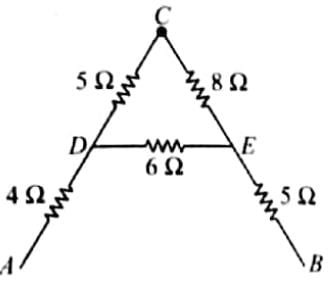
- a)13.1Ω
- b)15.1Ω
- c)17.1Ω
- d)19.1Ω
Correct answer is option 'A'. Can you explain this answer?
The equivalent resistance between A and B for . the circuit shown in this figure is


a)
13.1Ω
b)
15.1Ω
c)
17.1Ω
d)
19.1Ω
|
|
Riya Banerjee answered |
For a equivalent resistance betweeen A and B.
5Ω and 8Ω resistance are connected in series. R' their equivalent resistance is parallel to 6Ω
∴ R = 5 + 8 = 13Ω and
R" = 78/19
Now 4Ω, R" an d 5Ω resistances are connected in series equivalent resistance between ,A and B
∴
5Ω and 8Ω resistance are connected in series. R' their equivalent resistance is parallel to 6Ω
∴ R = 5 + 8 = 13Ω and

R" = 78/19
Now 4Ω, R" an d 5Ω resistances are connected in series equivalent resistance between ,A and B
∴

In the circuit shown, current flowing through 25V cell is

- a)7.2 A
- b)10 A
- c)12 A
- d)14.2 A
Correct answer is option 'C'. Can you explain this answer?
In the circuit shown, current flowing through 25V cell is

a)
7.2 A
b)
10 A
c)
12 A
d)
14.2 A
|
|
Preeti Iyer answered |
Applying KVL in loop
ABCDA, ABFEA, ABGHA and ABJIA, we get
30 − i1 × 11 = −25… (i)
20 + i2 × 5 = 25... (ii)
5 − i3 × 10 = −25… (iii)
10 + i4 × 5 = 25... (iv)
Solving equations (i), (ii), (iii) and (iv) we get
i1 = 5A, i2 = 1A, i3 = 3A and i4 = 3A
Hence, current flowing through 25V cell is 12A.
ABCDA, ABFEA, ABGHA and ABJIA, we get
30 − i1 × 11 = −25… (i)
20 + i2 × 5 = 25... (ii)
5 − i3 × 10 = −25… (iii)
10 + i4 × 5 = 25... (iv)
Solving equations (i), (ii), (iii) and (iv) we get
i1 = 5A, i2 = 1A, i3 = 3A and i4 = 3A
Hence, current flowing through 25V cell is 12A.
The I - V characteristics shown in figure represents
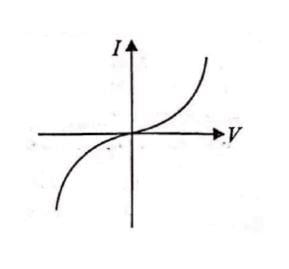
- a)ohmic conductors
- b)non-ohmic conductors
- c)insulators
- d)superconductors
Correct answer is option 'B'. Can you explain this answer?
The I - V characteristics shown in figure represents


a)
ohmic conductors
b)
non-ohmic conductors
c)
insulators
d)
superconductors
|
|
Suresh Iyer answered |
The figure is showing I-V characteristics of non-ohmic or non-linear conductors.
Figure (a) and figure (b) both are showing the variation of resistivity (p) with temperature (T) for some materials. Identify the types of these materials.
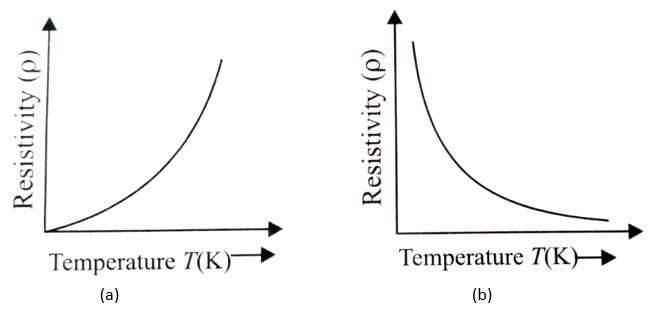
- a)Conductor and semiconductor
- b)Conductor and Insulator
- c)Insulator and semiconductor
- d)Both are conductor
Correct answer is option 'A'. Can you explain this answer?
Figure (a) and figure (b) both are showing the variation of resistivity (p) with temperature (T) for some materials. Identify the types of these materials.


a)
Conductor and semiconductor
b)
Conductor and Insulator
c)
Insulator and semiconductor
d)
Both are conductor
|
|
Riya Banerjee answered |
In conductors due to increasein temperature the resistivity increases and in semiconductors if the decreases exponentially.
The electrical resistance of a conductor depends upon- a)size of conductor
- b)temperature of conductor
- c)geometry of conductor
- d)all of these
Correct answer is option 'D'. Can you explain this answer?
The electrical resistance of a conductor depends upon
a)
size of conductor
b)
temperature of conductor
c)
geometry of conductor
d)
all of these
|
|
Riya Banerjee answered |
The electrical resistance of a conductor is depend upon all factors i.e., size, temperature and geometry of conductor.
In the circuit shown, the value of currents I1, I2 and I3 are
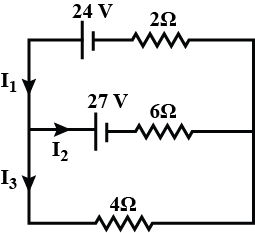
- a)

- b)

- c)5A, 4A, −3A
- d)

Correct answer is option 'A'. Can you explain this answer?
In the circuit shown, the value of currents I1, I2 and I3 are


a)

b)

c)
5A, 4A, −3A
d)

|
|
Dev Patel answered |
Applying Kirchhoff's voltage law,
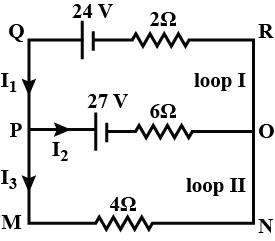
In loop I,
−27 − 6I2 − 2I1 + 24=0
6I2 + 2I1 = −3…(i)
In loop II,
−27 − 6I2 + 4I, + 24 = 0
6I2 − 4I3 = −27…(ii)
At junction P, I1 − I2 − I3 = 0…(iii)
Solving equations (i), (ii) and (iii) we get
I1 = 3A, I2 = −3/2A, I3 = 9/2A.

In loop I,
−27 − 6I2 − 2I1 + 24=0
6I2 + 2I1 = −3…(i)
In loop II,
−27 − 6I2 + 4I, + 24 = 0
6I2 − 4I3 = −27…(ii)
At junction P, I1 − I2 − I3 = 0…(iii)
Solving equations (i), (ii) and (iii) we get
I1 = 3A, I2 = −3/2A, I3 = 9/2A.
A wire has a resistance of 2.5Ω at 28∘C and a resistance of 2.9Ω at 100∘C. The temperature coefficient of resistivity of material of the wire is- a)1.06 × 10−3∘C−1
- b)3.5 × 10−2∘C−1
- c)2.22 × 10−3∘C−1
- d)3.95 × 10−2∘C−1
Correct answer is option 'C'. Can you explain this answer?
A wire has a resistance of 2.5Ω at 28∘C and a resistance of 2.9Ω at 100∘C. The temperature coefficient of resistivity of material of the wire is
a)
1.06 × 10−3∘C−1
b)
3.5 × 10−2∘C−1
c)
2.22 × 10−3∘C−1
d)
3.95 × 10−2∘C−1
|
|
Priya Menon answered |
Here, R1 = 2.5Ω, T1 = 28∘C
R2 = 2.9Ω and T2 = 100∘C
As R2 = R1[1 + α(T2 − T1)]
∴ 2.9 = 2.5[1 + α(100 − 28)]

=
= 2.22 × 10−3∘C−1
R2 = 2.9Ω and T2 = 100∘C
As R2 = R1[1 + α(T2 − T1)]
∴ 2.9 = 2.5[1 + α(100 − 28)]

=

= 2.22 × 10−3∘C−1
A circuit has a section ABC if the potential at point A, B and C are V1, V2 and V3 respectively, calculate the potential at point O is- a)V1 + V2 + V3
- b)

- c)zero
- d)

Correct answer is option 'B'. Can you explain this answer?
A circuit has a section ABC if the potential at point A, B and C are V1, V2 and V3 respectively, calculate the potential at point O is
a)
V1 + V2 + V3
b)

c)
zero
d)

|
|
Vivek Patel answered |
Applying juction rule −I1 − I2 − I3 = 0
i.e., I1 + I2 + I3 = 0
Let, V0 bet the potential at point O. By Ohm's law for resistance, R1, R2and R3 respectively, we get

So substituting these values of I1, I2 and I3 in eq. (i), we get


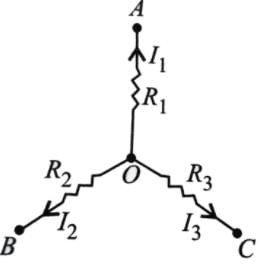
i.e., I1 + I2 + I3 = 0
Let, V0 bet the potential at point O. By Ohm's law for resistance, R1, R2and R3 respectively, we get

So substituting these values of I1, I2 and I3 in eq. (i), we get



Chapter doubts & questions for Current Electricity - NCERTs at Fingertips: Textbooks, Tests & Solutions 2025 is part of NEET exam preparation. The chapters have been prepared according to the NEET exam syllabus. The Chapter doubts & questions, notes, tests & MCQs are made for NEET 2025 Exam. Find important definitions, questions, notes, meanings, examples, exercises, MCQs and online tests here.
Chapter doubts & questions of Current Electricity - NCERTs at Fingertips: Textbooks, Tests & Solutions in English & Hindi are available as part of NEET exam.
Download more important topics, notes, lectures and mock test series for NEET Exam by signing up for free.

Contact Support
Our team is online on weekdays between 10 AM - 7 PM
Typical reply within 3 hours
|
Free Exam Preparation
at your Fingertips!
Access Free Study Material - Test Series, Structured Courses, Free Videos & Study Notes and Prepare for Your Exam With Ease

 Join the 10M+ students on EduRev
Join the 10M+ students on EduRev
|

|
Create your account for free
OR
Forgot Password
OR
Signup to see your scores
go up within 7 days!
Access 1000+ FREE Docs, Videos and Tests
Takes less than 10 seconds to signup









